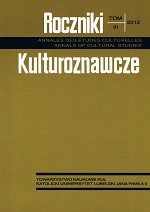Religijno-kulturowa funkcja relikwiarzy. W kręgu genezy obrazowania ciała świętych w sztuce europejskiej
Cultural-religious Function of Reliquaries. From the Circle of the Origins of Depicting the Bodies of Saints in European and Polish Art
Author(s): Małgorzata Urszula MazurczakSubject(s): Cultural Essay, Political Essay, Societal Essay
Published by: Towarzystwo Naukowe KUL & Katolicki Uniwersytet Lubelski Jana Pawła II
Keywords: mosaics; colour; light; reliquaries; anthropomorphic; gold; precious stones; anthropology of the body; saint body; earthly body
Summary/Abstract: Works of art are an integral part of religious culture and they reflect its wealth in Christian piety. However, while methodology of research into works of religious art has consolidated its fixed and tested methods, interpretation of works in the context of cultural studies asks questions, raises doubts, and sometimes stirs up controversies. Nevertheless, one cannot help deliberating over the cultural-religious function of such significant evidences in the heritage of Christian culture as reliquaries, especially ones in the form of parts of the body, like the hand, foot, head, arm etc. In the aspect of the cult of relics of saints and the ways of practicing this cult, reliquaries have been discussed in detail in theological research, in hagiography of spirituality, as well as in the history e.g. of pilgrimages and of the cult of saints. The present deliberations try to interpret various forms of works of art connected with the cult of saints. Reliquaries in the form of parts of the body that serve keeping relics of saints evoke faith in sanctity and in the resurrection of bodies. It is in them that the mystery of resurrection of the body as a new body, with new features of the matter, has been illustrated. Its nature may be most adequately made evident by the nature of the light, brightness, radiating of colours. Even Roman mosaics filling the early Christian churches used the new artistic medium in depicting pictures of saints and of God. The form of the body divided into small tesserae implies the body that is “in pieces”, joined again with mortar into a new visual quality of joined pieces covered with gold and precious dyes. The technique of mosaic allowed rendering the shining and the brightness of colours, making one aware of the mystic matter and showing with the use of artistic means the nature of a saint’s body as a “new body”. In this way mosaics and reliquaries make it easier for the faithful to realize the mystery of the “new body” of the saint and the resurrected martyrs. This is why the mosaic décor, especially in the apses and the places where relics of saints are placed in early Christian Rome churches, is compared to reliquaries that were common in medieval Europe and in Poland. They belong to the common heritage of religious culture that in a sensual way showed the mysteries of resurrection of the bodies of martyrs and of their relics. Artistic objects participate in the Church’s teaching and faith, constituting the mutual heritage of art and faith.
Journal: Roczniki Kulturoznawcze
- Issue Year: 2012
- Issue No: 3
- Page Range: 45-66
- Page Count: 22
- Language: Polish

